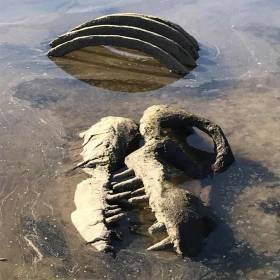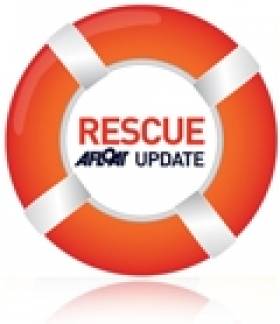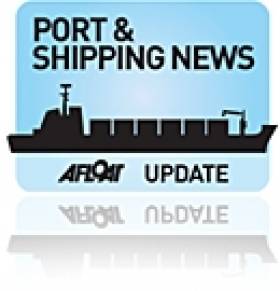Displaying items by tag: River Boyne
It’s been confirmed that two of three logboats spotted by drone in the River Boyne in recent weeks are new discoveries, and could date from medieval times.
As previously reported on Afloat.ie, citizen archaeologist Anthony Murphy captured the first of his unique aerial images while searching for a dolphin that’s been delighting Drogheda’s denizens.
Over subsequent days he spotted the outlines of two more logboats in close proximity, though he presumed they were among a number of such vessels already known to the National Monuments Service (NMS).
But as RTÉ News reports, the NMS has now confirmed that the first and third boats spotted by Murphy are indeed new discoveries — and could date from the Norman fortification of Drogheda.
RTÉ News has more on the story HERE.
A citizen archaeologist may have spotted the remains of two previously unknown medieval logboats in the River Boyne.
Last week, The Irish Times reported on Anthony Murphy’s drone footage of a rectangular object in the riverbed captured on Monday 26 April, while he was observing for the dolphin recently spotted in the river near Drogheda.
The National Monuments Service (NMS) suggests this may be a vessel first discovered last year and which could be as much as 1,600 years old.
Subsequently, Murphy reported a second sighting on Wednesday 28 April, at a location some 200 metres from the previous find.
“It appears to be upside down, is very flat-bottomed and is larger than the first one,” he wrote on Twitter.
Further aerial investigations over the weekend revealed what appears to be a third logboat some 400 metres downstream of the first, west of the Bridge of Peace.
THIRD LOGBOAT SPOTTED!
— Mythical Ireland (@mythicalireland) May 2, 2021
I spotted a third logboat in the river Boyne at Drogheda this morning using my drone. It is located about 400 metres downstream of the first logboat I saw and reported on Monday last.https://t.co/yBc5ADlnmh pic.twitter.com/SS4o5xc92i
Murphy details the find on his blog Mythical Ireland, where he estimates this third vessel to be around 15ft in length.
However, he harbours no illusions that his “discoveries” have never been spotted previously.
“I’m assuming this is one of these ‘few’ logboats which NMS says it is aware of in the River Boyne at Drogheda,” he says. “However, the drone photography of same brings a new perspective on these ancient artifacts.”
As for why these remnants of Ireland’s ancient history are becoming easier to find now, Murphy believes it’s a combination of “exceptionally low” spring neap tides due to lack of rainfall, and clearer water due to reduced pollution in the river.
Dolphin in River Boyne Excites Drogheda Locals
The Irish Independent covers the excitement among the denizens of Drogheda after a dolphin swimming up the River Boyne paid an unexpected visit to the town.
Reports of a dog in the water yesterday morning (Thursday 22 April) turned out to be wide of the mark when Boyne Fishermen Rescue and Recovery encountered the “medium-sized dolphin” in the River Boyne at the Upper Mell slipway, just east of the town centre and some 7km from the open sea.
The Irish Whale and Dolphin Group says the marine wildlife is likely to be a bottlenose and called for the public to contact it with any images or reports of further sighings.
While there is no immediate cause for concern, dolphins are saltwater animals and can develop serious kidney and skin problems with prolonged exposure to freshwater environments.
Man Dies In Tragic Fishing Accident On River Boyne
Independent.ie reports that a man has died in an incident while fishing on the River Boyne near Townley Hall, outside Drogheda yesterday afternoon, Saturday 27 June.
It’s understood that a man in his 30s was taken from the river two hours after he was reported in difficulty and later pronounced dead in what is being regarded as “a tragic accident”.
Mystery Of ‘Dinosaur Bones’ Found In River Boyne
Drogheda Coast Guard had a prehistoric mystery on their hands earlier this week with what the station is calling “probably the most unusual tasking we ever had or ever will have”.
The coastguard team were tasked on Tuesday (26 February) after an emergency call reporting ‘dinosaur bones’ in the River Boyne close to Drogheda town centre.
And indeed when they arrived the volunteers discovered what appeared to be the skeletal remains of a Tyrannosaurus rex half-submerged in the mud.
But on closer inspection, the bones were revealed to be “a very impressive imitation”.
Drogheda Coast Guard officer in charge Dermot McConnoran told TheJournal.ie that the plaster-cast bones were covered in silt suggesting they’d been in the river for some time.
Further research has turned up images of the same skeleton “in a less river-worn state” from a little over a year ago. It’s not yet known who is responsible for its creation.
Teen Rescued After Falling Into River Boyne
#Rescue - The Irish Independent reports that a 13-year-old boy has been rescued after falling into the River Boyne in Drogheda last night (28 December).
It's believed the boy had been playing close to the edge of the river opposite the Louth town's Garda station when he slipped into the water.
The casualty was kept afloat by a life ring thrown by a passer-by till he was rescued by the Irish Coast Guard.
The Irish Independent has more on the story HERE.
Howth Coast Guard Assists Powerless Boat In Drogheda
#Coastguard - The Howth unit of the the Irish Coast Guard responded this weekend to a vessel that lost power at the mouth of the River Boyne.
Howth's coastguard crew were undertaking helm training with a passage to the Drogheda unit to support the Drogheda Marina launch when they were notified that a ski-boat planning to join the flotilla had lost power on the Drogheda Bar.
The vessel, with four people aboard, was taken under tow - while a mother and child on a second vessel suffering from serious sea-sickness were also transferred to the coastguard boat.
As previously reported on Afloat.ie, the Drogheda Port Company undertook dredging works in January this year on the entrance to the port on the River Boyle, following earlier works in 2010 to remove sand accumulating at Drogheda Bar.
Arklow Vessel Sets Record Cargo for Drogheda Port
#PORTS & SHIPPING – Drogheda Port set a record tonnage cargo with the arrival of Arklow Bridge (2011/4,723grt) last week. The vessel operated by Arklow Shipping N.V. as previously reported on Afloat.ie had carried 7,125 tonnes of maize, the largest ever single cargo handled in the Co. Louth port, writes Jehan Ashmore.
Arklow Bridge is the second 'B' class vessel that was built last year and the Dutch-flagged vessel loaded the cargo of maize in the Polish city of Gdynia for Comex McKinnon. The company is a leading player in the importation and trading of feedstuffs for the animal feed sector in Ireland.
Stevedoring services were handled by Fast Terminals, a new company which is a joint venture between Drogheda Port Company and Fast Shipping of Antwerp. The company became operational last Septemberand increases the number of stevedoring operations in the port to four.
Drogheda Port is developing its agri-sector business so to transport feedstuffs for the animal feed sector in Ireland. The agri-food sector is worth €7.8bn and is proving resilient, despite the downturn and growth from this indigenous sector will be vital to the country's overall economic recovery.
According to Drogheda Port Company, planning permission was recently received for the development of a 5,400sq m bulk storage facility at the Tom Roes Point Terminal. The downriver facility is situated closer to the open sea compared to the towns quays on the banks of the Boyne.
Mr Paul Fleming, Drogheda Port Chief Executive said "Drogheda Port continues to provide a strategic import and export location for our customers with a service which is more flexible and cost competitive than other larger ports".
He added: "This is helping us to win new contracts and grow our business in addition to providing a platform to Ireland's importers and exporters to reach their markets more cost competitively."
Mr Simon Mulvany, Director of Fast Terminals said "Fast Terminals has identified the competitive opportunities that Drogheda Port can offer our company. Despite the current economic downturn we intend to invest in the port and develop our facilities to cater for further growth in the future."
Former Dutch Dredger on the Boyne
#PORTS & SHIPPING- Berthed at the Steam Packet Quay, Drogheda is the suction-trailer dredger Lough Foyle (1979/868grt) which is on contract work with the Drogheda Port Company, writes Jehan Ashmore.
Following the sale last month of Hebble Sand, as previously reported on Afloat.ie (clcik HERE), the Lough Foyle (PHOTO) is now the only port-owned dredger on the island of Ireland. The Londonderry Port & Harbour Commissioners (LPHC) purchased the vessel from Dutch interests in 2009. She was originally the Saeftinge, built in 1979 at the Van Goor Scheepswerf in Monnickendam.
Since her introduction she has performed previous dredging operations to include the Drogheda Bar leading into the Co. Louth port. Her most recent contract was in Waterford Estuary, from where she arrived from on Tuesday after an overnight voyage.
In addition she has worked at the new Stena Line ferryport terminal at Loch Ryan, Cairnryan, to see related report click HERE. The Scottish ferryport is due to be officially opened tomorrow, to read more including the newly introduced 'Superfast' sisters click HERE.
Drogheda Welcomes New Gas Operator
The Co. Louth port recently welcomed the 4,750 tonnes MV Thresher, the largest ever gas tanker which was making a delivery of over 1,300 metric tonnes of gas to the Flogas terminal on the banks of the river Boyne. The Thresher is operated by Chemgas, a new shipping company for the Flogas plant, which employs approximately 100 people.
"Chemgas operates some of the most modern and best equipped gas carriers in the world, so we are delighted to have them as our new shipping company," said Paul O'Connell, Flogas operations director.
In welcoming the new generation of gas tanker, Mr Paul Fleming, CEO of Drogheda Port Company stated that "Flogas is one of the ports premier customers and its commitment to the future development of its facility and the port is reflected in its use of larger and more efficient vessels with an improved carbon footprint".
Chemgas is a Dutch based shipping company which commissioned the 100m Thresher which was built in 2006 and entered service the following year.






































































